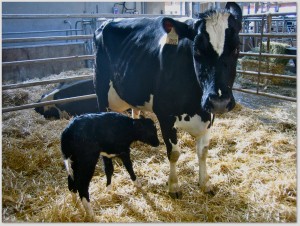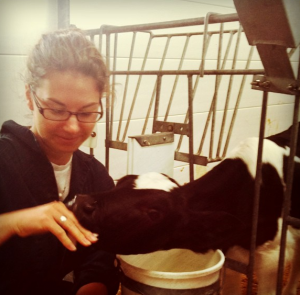Think about that cool refreshing milk you had with your cereal this morning, those thick slices of melted cheese cuddled between layers of ham in that sandwich you had for lunch, and that silky-smooth ice cream you savoured guiltily for dessert last night.
What do they all have in common?
The answer is simple – dairy.

Milk and yogurt are examples of dairy products. (Source: Wikimedia)
Classified as one of Canada’s four basic food groups in the “Milk and Alternatives” category, a simple 2-3 servings of dairy per day (for adults) will help keep your bones and teeth stay strong and healthy! But wait just a second, how exactly did they end up in the dairy aisle of grocery stores?
Prior to the process of lactation, or secretion of milk, in the dairy cow, she must first give birth to a calf. After delivering the calf, the cow is then able to produce large quantities of milk. This is when the milk will subsequently become processed to be made into a variety of goods, such as cheese, yogurt, butter, and ice cream.
A recent research carried out by Beth Ventura, a PhD student at the University of British Columbia (UBC), and three other colleagues in the Animal Welfare Program at UBC, aimed to gather the perspectives and opinions of the public regarding the welfare of dairy cattle. Specifically, the controversial dairy practice of cow-calf separation was examined and the results retrieved from the online forum was hardly a shock. It was almost predictable that a 50/50 split would occur between supporters and opponents of this practice.
So now you’re probably thinking, what is cow-calf separation?

A dairy cow and her calf. (Courtesy of Beth Ventura)
Cow-calf separation is a practice that is conducted in the majority of dairy farms today. It is the procedure of separating the baby calf from the mother within a few short hours of being born and then housing them separately. The mother cow would, after recovering, regroup with the other cows to be reintegrated into milking.
This has become a highly debatable topic among various stakeholders. One reason being that the colostrum, or the first milk, is able to provide the calf with strengthened immunity from diseases. With separation, the farmer is able to ensure that the calf is getting enough colostrum, whereas without, the amount being received becomes unknown, thus making the calf more prone to illnesses.
Watch and listen as Beth Ventura gives an overview of her research in the video below.

The findings of this research are important as they illustrate the potential to identify areas of agreement and conflict among stakeholders, consisting of farmers, veterinarians, and even us consumers, so that a positive public image of the dairy industry can be retained.
Check out the podcast below for suggestions made by Ventura in raising public awareness, as well as the implications faced during the experiment, along with her motivations.
Audio clip: Adobe Flash Player (version 9 or above) is required to play this audio clip. Download the latest version here. You also need to have JavaScript enabled in your browser.
These researchers hope to encourage the involvement of scientists to gather better scientific evidence, thus allowing changes in the practice to be made in accordance with societal concerns.
By Cindy Hu, Miranda Tuet, and Ye Jin Park (Group 5)

